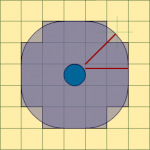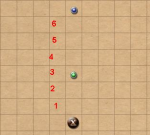I'm too lazy/sleepy to bust out my calculus for an exact percentage, so we'll go with another visual representation. Those corner squares are less than 50% covered, and a 10-foot line doesn't even quite touch the center of the corner squares. (Which are what, around 10.6 feet away?)ainatan said:Radius and reach are not the same thing.
The reach start from "all around" the attacker's square.
Radius is measured from a same point.
In the reach diagram, it makes perfectly sense that the attacker could hit the creature on the corner squares. It could at least affect 50% of the square in the corner, so it's enough to reach anyone there.
I'm pretty sure that the corners being covered by 10-foot reach is just to prevent the anomaly where an attacker can approach from certain directions and not suffer attacks of opportunity.
I agree, and it's more a symptom of the designers trying to use one mechanic to cover everything. 10-foot radii work fine for attack spells. It's only emanations that cover the caster where you get the logical breakdown, and it's because of the rule that all area effects (except reach) radiate from a specific corner. Personally, I don't know anyone who's tried to enforce this in the case of spells like Magic Circle Against Evil/whatever. Asking the caster to declare a corner every turn is silly. It's somewhat illogical that some people who are 10 feet away, or even 5 feet away from the target in certain cases, aren't covered in a 10-foot radius emanation, so every time I've seen the spell cast those mechanics get ignored.ainatan said:In the radius diagram, the 'logical' 10ft. radius circle is really a little wider than that.
If you put a 10ft. radius circle on the grid, like I did in the last diagram, the actual 10ft radius circle works well. IIRC there is a rule (of thumb?) in D&D that says "if the area of the effect covers less than 50% of the area of a square, a creature in the square is not affected". That's what happens with the Actual 10'R circle.
There's still the issue with the 1-2-1-2 system that cones cover more area if you direct them "straight out" than "diagonally." Of course moving to a 1-1 system doesn't promise any answers there. It would just make things worse.
So anyways, I guess my point is that none of the systems are perfect. They all lead to strange unintuitive situations and weird exceptions. The 1-1 system has as its advantage that it's easier to count, and in my book, that's a pretty big advantage.




